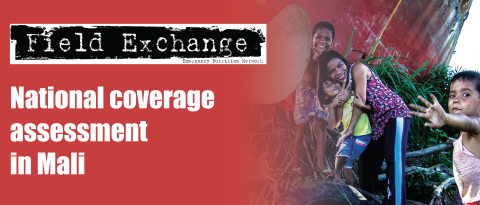Efficacy of a community-embedded RUTF programme to treat childhood malnutrition in Kapanga, DRC
By Ivan R. Molton, Rukang Chikomb, Marie Chilembe, Alice Rowe, Rodolph Rowe and Chingambu Tshiseng

Ivan Molton is an Associate Professor in the Department of Rehabilitation Medicine at the University of Washington, Seattle, USA. His role in the programme included selecting and measuring treatment outcomes, performing statistical analysis of efficacy data, and sharing results.

Rukang Chikomb grew up in the village of Musumba, and is now a pilot for UMC aviation ministry, and Director of Southern Wings of The Morning based in Lubumbashi. He served as pilot, interpreter, and chief logistics and personnel coordinator for the nutrition programme.

Marie Chilembe works primarily in the Obstetrics division at Samuteb Hospital in Musumba, DRC. For the current nutrition project, she served as the Supervising Nurse, and as an on-the-ground staff trainer and project manager.

Alice Rowe has worked with non-profit groups serving in DRC for more than 10 years. Along with her husband, she serves as the programme coordinator, focusing mainly on US-Congo shipping and travel logistics and communication.

Rodolph Rowe has advocated for African children for more than a decade, including serving on the Board of the United Methodist Church’s Hope for the Children of Africa programme. His work in DRC includes helping with the ongoing development of girls’ and boys’ orphanages in Kinshasha, as well as serving as a programme coordinator for the Masumba childhood nutrition programme.

Chingambu Tshiseng is a public relations manager for the Southern Congo Wings of the Morning programme based in Kapanga. He served as key interpreter, and materials/finance coordinator for the Musumba nutrition programme.
Location: Democratic Republic of Congo (DRC)
What we know: Severe acute malnutrition is prevalent in the DRC. Sustainable community-based management is hampered by dependence on external inputs, such as trained staff and supply of ready-to-use therapeutic foods (RUTF).
What this article adds: The feasibility and efficacy of a small-scale, community-based and managed childhood RUTF programme in the Kapanga valley region of the DRC was investigated. Non-standard entrance criteria (visible signs) and target population (0-13 years) were decided by the local programme leads. On balance, challenges (logistics, inaccessibility, one-third did not meet standard admission criteria) were outweighed by success (moderate weight gain rate for two-thirds of admissions using locally sourced product).
The programme resulted in considerable improvement in approximately two-thirds of participants suffering from MAM or SAM, using local leadership and a product that was primarily locally sourced
Background
Childhood malnutrition remains a significant problem for world health, affecting an estimated 99 million children under the age of 5 worldwide.1 One region in which malnutrition is endemic is the Democratic Republic of Congo (DRC). The First and Second Congo Wars (1996-2007) led to the death of as many as six million civilians,2,3 the total destruction of most essential infrastructure, and an external debt equalling approximately 900% of annual exports.4,5 As a result, there has been a significant decline in agricultural production across the DRC, especially in subsistence crops like cassava, plantain, and maize.6 Sixty two percent of the Congolese population are below the age of 15, and an estimated 44-48% of these experience chronic malnutrition and stunting6,7. Clinically, severe acute malnutrition (SAM) is evidenced in approximately 6% of rural Congolese children, with markers such as oedema present in 10%.8 In periods following civil unrest, rates of paediatric SAM in DRC have climbed as high as 23%.9
One approach to treating SAM is through ready-to-use therapeutic foods (RUTF). Unfortunately, the availability of commercial RUTF in rural and impoverished regions is often limited, due to the relatively high cost of Western brands, or to local policies that prohibit importation of foreign food products10. In response to these challenges, there have been recent calls for innovative, sustainable, effective programmes that utilise locally obtainable food products in the production of RUTF11, and that rely upon a community-based therapeutic care model to deliver RUTF12,13. Ideally, such programmes would include RUTF preparations derived exclusively from local food sources, and could be produced with local labour in a village setting using minimal technology.14,15
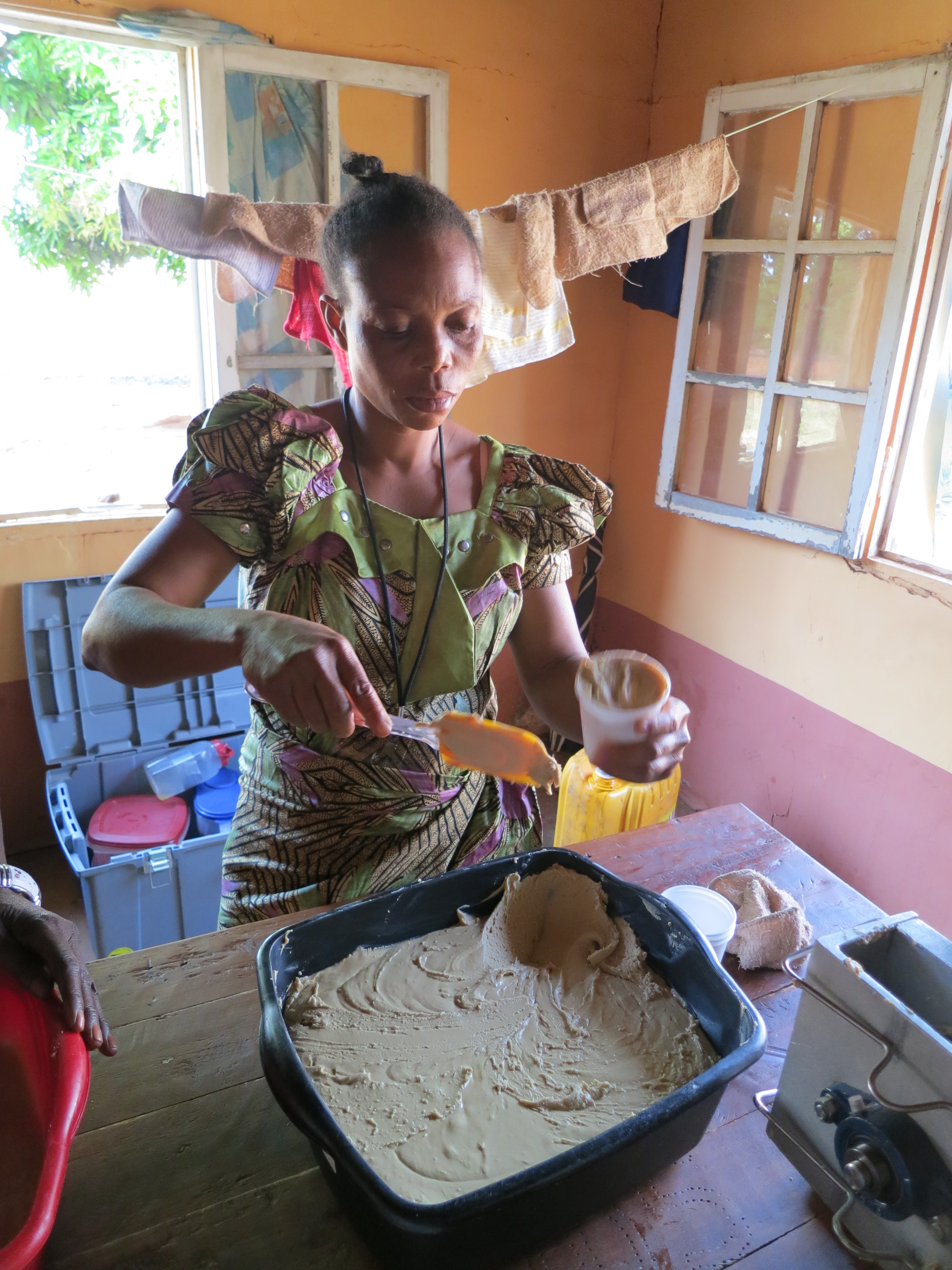 Programme location and goals
Programme location and goals
This project’s broad objective was to evaluate the feasibility and efficacy of a small-scale, community-based childhood RUTF programme in the Kapanga valley region of the DRC. This involved creating an RUTF production and delivery system that was almost entirely staffed and managed by the local population, with goals established through dialogue with local village leadership. It was our hope that this community-embedded approach might be scalable and sustainable, with the local population taking control of the nutritional needs of their own small region.
Kapanga is a rural territory (district) in the northwest corner of the Katanga province, with a population of about 120,000 inhabitants in a land area of 32,000 km2. One of the poorest territories in the region, there is almost no electricity and it is often inaccessible due to the deterioration of the roads and lack of railroads. This pilot project took place in Musumba village, which is a rural centre in Kapanga and home to approximately 45,000 individuals. The population lives primarily off small-scale subsistence farming and river fishing, with the majority of daily calories coming from consumption of dried and ground cassava root flour. This makes for a diet high in carbohydrates but with little protein, fat, or essential minerals and paediatric SAM is highly prevalent.
 Testing the RUTF programme
Testing the RUTF programme
Timeline and procedure
In June of 2011, two US volunteers arrived in Musumba, and worked with village leaders to select a group of nine individuals to manage the RUTF programme. The ‘Nutrition Team’ was provided with training and equipment to produce the RUTF, including two hand operated Omega Grinders (www.compatibletechnology.org), a 4 gallon stainless steel mixer (manufactured by Cabelas, USA), and a paediatric spring scale. One local experienced nurse was trained to identify children at risk for severe malnutrition in the community. After training, the US team worked with the DRC Nutrition Team to coordinate delivery of locally sourced peanuts, milk powder, and sugar from Lubumbashi. All members of the Nutrition Team were paid a salary of $10US per month, an amount recommended by village leadership and consistent with the local economy. Two local individuals were selected to serve as leaders for the programme, as they were tri-lingual, literate, and could provide regular reports to the US team.
Following this training, the Nutrition Team was provided with a 12 month supply of a multi-vitamin powder (described below), and left to administer the programme on their own. Quarterly reports (including child height/weight data, budget, and status of supplies), were sent to the US team via an air courier (a local Aviation Mission Fellowship pilot who made infrequent trips to the village for other reasons and was willing to photocopy and email hand written reports from his base in Lubumbashi). The US team was also available to help remotely with problem-solving and logistics as needed, and returned in June of 2012 and June of 2013 to monitor progress and address problems.
Programme admission criteria
In order to maximize local participation and a sense of ownership in the programme, the US team did not dictate entrance criteria to the programme. Rather, entrance criteria were established through iterative discussion with the local Nutrition Team. Although the US team provided education on standard assessment measures, such as mid-upper arm circumference (MUAC) and weight-for-height, the nurses on the local Nutrition Team stated a strong preference to rely on observable clinical indicators of malnutrition. The US team therefor provided education regarding observable signs of SAM, including prominent bones, skinny limbs, hair changes (scanty, light), skin changes (loose skin on lifting, baggy around buttocks), a large, protuberant belly, and/or the presence of nutritional oedema. Nurses were also trained to collect child height/weight data for outcomes measurement.
The US team suggested limiting the programme to children between 6-59 months of age. However, this decision was rejected by village leaders. Again, because sustainability and local ownership was essential, the US team worked with village leaders to set a maximum cut off age (of 13 years) for entrance into the programme. For purposes of this report, separate efficacy analyses were conducted for children below and above the age of 5 years. The decision to allow the Nutrition Team this degree of control over entrance criteria reflected a need for balance between local ownership and programme efficacy.
RUTF delivery and composition
Children in the programme received a seven day quantity of the RUTF during each of four weekly visits with Nutrition Team staff, for a total supplementation period of 28 days. The RUTF product in the present trial consisted of 27.5% locally grown peanuts, as well as 27.5% milk powder, 27.5% sugar and 17.5% vegetable oil purchased in Lubumbashi, DRC. The powdered multivitamin for the RUTF included vitamins A and B, folic acid, iodine, iron, magnesium, potassium and zinc, and made up 1.5% of total RUTF volume. After grinding and mixing, 100 grams of this RUTF was designed to contain approximately 558 calories, 37.1g crude fat, and 13.9g protein. However, lack of local electricity or access to a nutritional analysis laboratory made on-site nutritional testing of the product unfeasible.
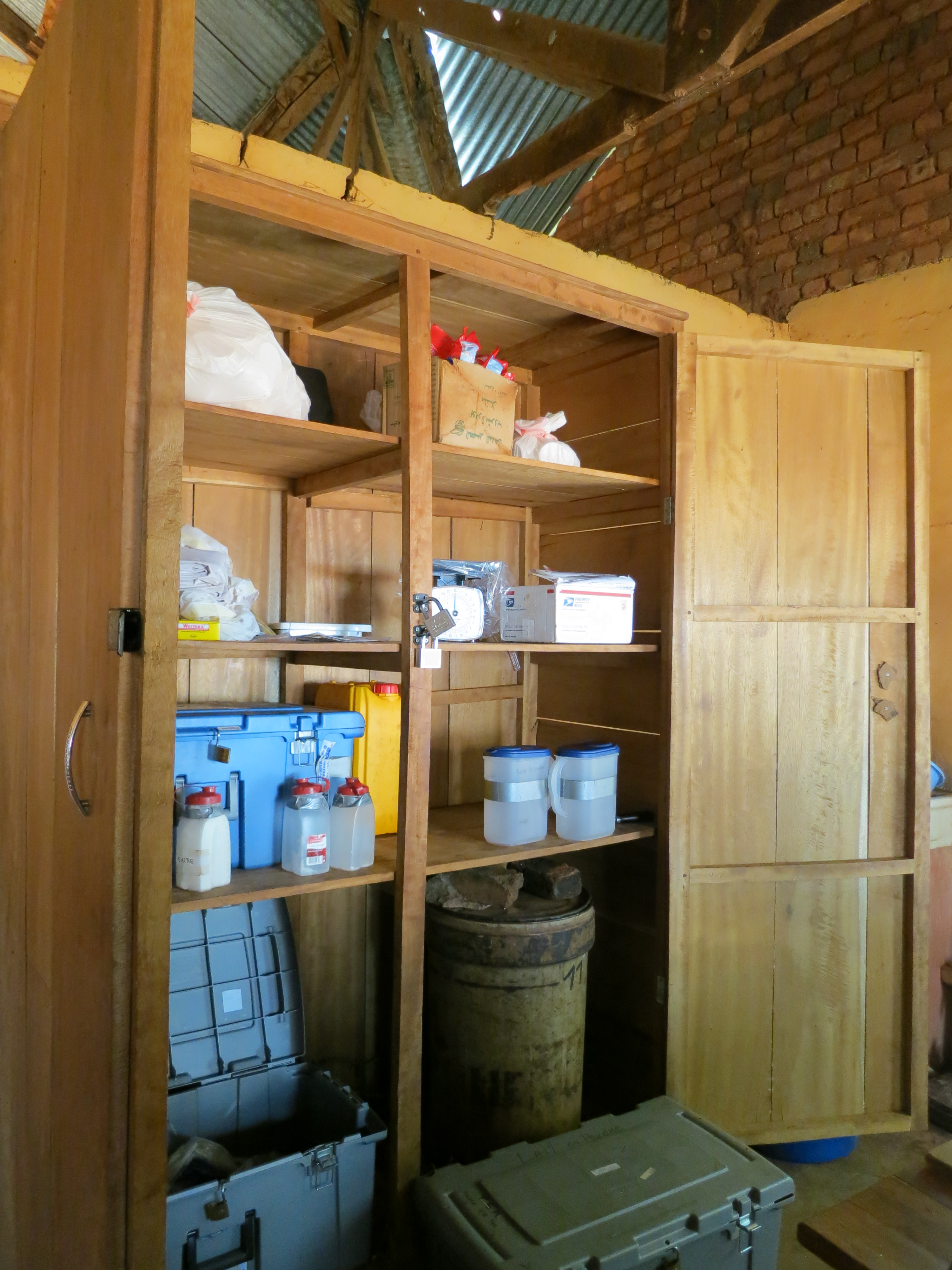 Results
Results
Programme participants
Overall, 145 children participated in the programme between May 2012 and May 2013, having been identified on the basis of presence of clinical indicators described above. Of the 145 children who started the programme, 126 completed it (making for a completion rate of 88.7%), and the average number of days in the programme was 34.5. Defaulters were more likely to be girls than boys (χ2 = 3.6, p = .06) and to have lower weight at study entry (9.7kg vs. 11.4kg; t = -2.1, p < .05). There were no other significant demographic predictors of study non-completion. Based on height/weight and age data collected by nursing staff, at baseline, 43.2% of these 126 children met WHO criteria for severe acute malnourishment [weight-for-height score (WHZ) of <-3], and an additional 21.6% were moderately acutely malnourished (WHZ <-2 but ≥-3).
As a consequence of the Nutrition Team’s reliance on clinical observation, more than one third of the children who entered the programme (35.2%) had WHZ scores from 0 to -2, meaning that they were underweight but not acutely malnourished according to WHO criteria. These children were excluded from statistical analyses for purposes of programme evaluation. No child had a WHZ score above 0 at baseline. In all cases, children who continued to meet criteria for MAM or SAM after programme completion were allowed to re-enter the programme, although their follow-up data are not yet available for analysis.
The final sample for analysis therefore included 83 children who completed the four week programme, and met criteria for either MAM or SAM at baseline. These children were more likely to be boys (69.9%) than girls (30.1%), with an average age of 5.3 years (ranging from 6 months to 13 years).
Outcomes selection
To determine the efficacy of the RUTF programme, we tested the following outcomes via independent and pairwise t-tests, using SPSS version 20.0:
- WHZ before and after the programme
- Percentage of children meeting SAM criteria at baseline who did not meet this criteria at programme completion, and
- Rate of weight gain in grams per kg per day.
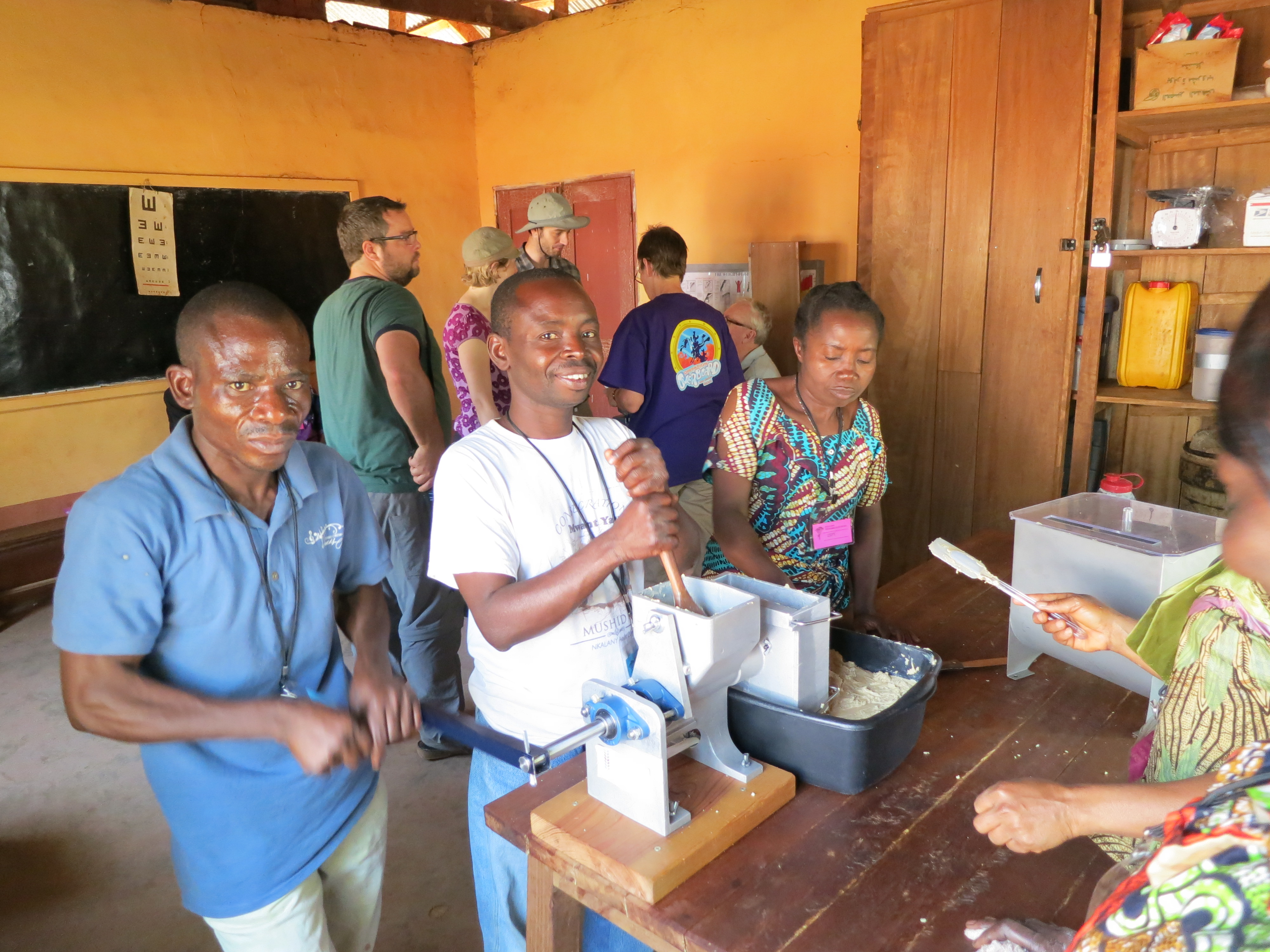 Programme efficacy
Programme efficacy
Efficacy below age 5 years: Forty-nine children in the programme were below five years of age; the average age was 3.5 years, and most (71.4%) were boys. The average WHZ score on study entry for this group was -2.57, with 43% meeting anthropometric criteria for MAM and 57% meeting criteria for SAM. Mean weight gain during the programme for these children was 1.8kg (SD =1.05kg), or 20.1% of pre-programme weight; this change was statistically significant (t=12.1, p <.001). Mean rate of weight gain was 6g per kg per day.
Looking only at children who met criteria for SAM at baseline, we see that the programme resulted in recovery for 14 (50%; WHZ > -2), and improvement to MAM for another 7 (25%; WHZ <-2 but ≥-3). Seven of these children (25%) continued to meet criteria for SAM after programme completion.
Efficacy above age 5 years: In total, 34 children over the age of five years completed the programme. A total of 67.6% were boys, mean age 7.8 years and mean BMI 11.4 (WHZ = -2.9). Of these 34 children, 79.4% met criteria for SAM and 20.6% for MAM. Mean weight gain during the programme was 2.0kg (SD =1.9kg), or 17.2% of body weight, at a rate of 5.11g per kg per day. This weight change represented a 1.87 point increase in average BMI, and was statistically significant (t = 6.2, p < .001).
Of the 27 children over age five who met criteria for SAM at baseline, 12 (44.4%) recovered and six (22.2%) improved to MAM. Nine children (33.3%) continued to meet criteria for SAM after the programme.
Differences in efficacy by age group: There were no significant differences between children under 5 and those over 5 in terms of percentage weight gain (20.1% vs. 17.2%; t = 0.92, p =.36) or in rate of weight gain, expressed in grams per kg per day (6.0 vs 5.1; t = 0.91, p =.39).
 Summary and conclusions
Summary and conclusions
This programme tested a community-embedded model to deliver RUTF to malnourished children in a remote setting in the DRC. To our knowledge, this is one of the first programmes in the DRC in which the production and delivery of RUTF was administered entirely by members of the local population with minimal external support, and in close collaboration with village leadership and regional tribal elders. With the exception of a brief period of training from outside staff, supplies, and ongoing monitoring, the programme was entirely community-embedded and managed by the local people.
Data from this programme would suggest that the approach was effective, with an average weight gain (collapsed across ages) of 1.9kg over a 35 day period, at the average rate of 5.6g per kg per day. This weight gain would be considered moderate, and is within the range of other reports of RUTF efficacy, including those of hospital based nutritional rehabilitation in India16, and of community and home-based trials in Malawi,17,18 Niger19 and Uganda20. Perhaps more importantly, approximately half of the children suffering from SAM at admission to the programme met WHO community discharge criteria21 (WHZ ≥-2) 30 days later, with an average percentage weight gain (18.9%) consistent with WHO recommendations of 15-20%.
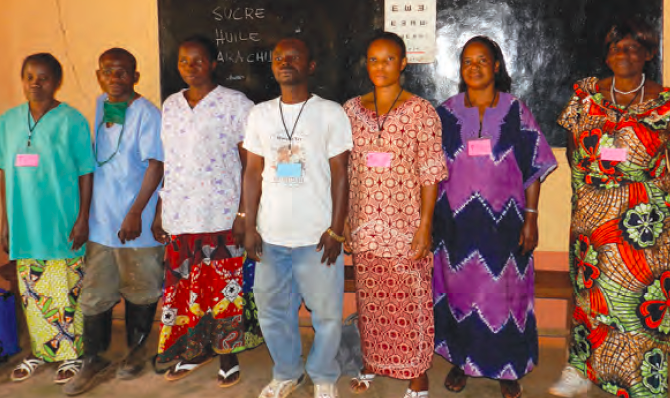 Technical challenges and lessons learned
Technical challenges and lessons learned
The community-embedded approach described here is designed to maximize local ownership and sustainability. However, such an approach naturally brings with it unique challenges and is an iterative process. For example, the decision of the local Nutrition Team to rely on clinical evaluation by a nurse to determine malnutrition created a high false positive rate for study entry. Nearly one third of the individuals who entered the programme did not meet WHO standards for acute malnutrition and although still underweight, were not the individuals for whom the programme was designed (nor were they included in the analyses described here). From one perspective, RUTF is a highly specialised food formulated for treating SAM, and the decision to treat these children may have drawn resources away from those who could most benefit from it. From another perspective, the freedom for the local Nutrition Team nurses to use their own clinical judgment brought with it a greater sense of partnership and collaboration, and it could be argued that a high false positive rate is better than a high false negative rate in treating rural malnutrition. However, now that the data are available, the US will provide the local Nutrition Team with feedback about the breakdown of children entering the programme, and will modify the entrance requirements to employ standard measures such as MUAC. We also hope to get a better estimation of the geographical coverage of the programme, to determine areas of unmet need.
Aside from these programmatic issues, the location of this intervention brought with it a slew of technical challenges. Masumba village is incredibly remote - during the dry season, it is a two week trip by truck from the nearest major city. This distance created a significant barrier in terms of supplies and communication to monitor progress. The isolated nature of this village, including a lack of electricity or fuel for generators, limited our ability to perform ongoing quality control of the product in the field. Aflatotoxin in peanuts is a serious concern in the DRC, and ongoing training of staff to minimize this risk through proper sorting, storage, and worker hygiene is essential.
There are also significant systems challenges to working in the DRC. Due to systemic corruption, negotiation with governmental agencies in DRC is very nearly impossible, and significant losses in materials can occur in transit. There are also strong political sentiments associated with foreign aid. Poorly designed US and French attempts over the past century to create infrastructure have led to a pervasive mistrust of external solutions. Local involvement and buy-in, especially from tribal leadership in this region, was essential to the success of our pilot programme.
Despite these challenges, we consider this trial programme to be a success. The programme resulted in considerable improvement in approximately two-thirds of participants suffering from MAM or SAM, using local leadership and a product that was primarily locally sourced. As future refinements are made to the programme, we are hopeful that these data will show improvement as we are better able to identify and serve children in need of nutritional intervention.
For more information, contact: Ivan Molton, email: imolton@u.washington.edu
1. 2012 Join child malnutrition estimates - levels and trends. 2012.
2. Coghlan B, Brennan RJ, Ngoy P, et al. Mortality in the Democratic Republic of Congo: a nationwide survey. Lancet. Jan 7 2006;367(9504):44-51.
3. Coghlan B, Ngoy P, Mulumba F, et al. Update on mortality in the Democratic Republic of Congo: results from a third nationwide survey. Disaster Med Public Health Prep. Jun 2009;3(2):88-96.
4. Bank W. World Development Indicators 2009. Washington, D.C.: The World Bank; 2009.
5. UNDP. D.R. Congo Human Development Report. New York, NY: United Nations Development Programme; 2007.
6. Kandala NB, Madungu TP, Emina JB, Nzita KP, Cappuccio FP. Malnutrition among children under the age of five in the Democratic Republic of Congo (DRC): does geographic location matter? BMC Public Health. 2011;11:261.
7. UNICEF. The state of the world's children. New York, NY: UNICEF; 2007.
8. Porignon D, Katulanya I, Elongo L, et al. The unseen face of humanitarian crisis in eastern Democratic Republic of Congo: was nutritional relief properly targeted? J Epidemiol Community Health. Jan 2000;54(1):6-9.
9. Public health impact of Rwandan refugee crisis: what happened in Goma, Zaire, in July, 1994? Goma Epidemiology Group. Lancet. Feb 11 1995;345(8946):339-344.
10. Enserink M. Nutrition science. The peanut butter debate. Science. Oct 3 2008;322(5898):36-38.
11. Dibari F, Diop el HI, Collins S, Seal A. Low-cost, ready-to-use therapeutic foods can be designed using locally available commodities with the aid of linear programming. J Nutr. May 2012;142(5):955-961.
12. Collins S. Changing the way we address severe malnutrition during famine. Lancet. Aug 11 2001;358(9280):498-501.
13. Brown KH, Nyirandutiye DH, Jungjohann S. Management of children with acute malnutrition in resource-poor settings. Nat Rev Endocrinol. Nov 2009;5(11):597-603.
14. Lin CA, Manary MJ, Maleta K, Briend A, Ashorn P. An energy-dense complementary food is associated with a modest increase in weight gain when compared with a fortified porridge in Malawian children aged 6-18 months. J Nutr. Mar 2008;138(3):593-598.
15. Manary MJ. Local production and provision of ready-to-use therapeutic food (RUTF) spread for the treatment of severe childhood malnutrition. Food Nutr Bull. Sep 2006;27(3 Suppl):S83-89.
16. Mamidi RS, Kulkarni B, Radhakrishna KV, Shatrugna V. Hospital based nutrition rehabilitation of severely undernourished children using energy dense local foods. Indian Pediatr. Aug 2010;47(8):687-693.
17. Ciliberto MA, Sandige H, Ndekha MJ, et al. Comparison of home-based therapy with ready-to-use therapeutic food with standard therapy in the treatment of malnourished Malawian children: a controlled, clinical effectiveness trial. Am J Clin Nutr. Apr 2005;81(4):864-870.
18. Patel MP, Sandige HL, Ndekha MJ, Briend A, Ashorn P, Manary MJ. Supplemental feeding with ready-to-use therapeutic food in Malawian children at risk of malnutrition. J Health Popul Nutr. Dec 2005;23(4):351-357.
19. Nackers F, Broillet F, Oumarou D, et al. Effectiveness of ready-to-use therapeutic food compared to a corn/soy-blend-based pre-mix for the treatment of childhood moderate acute malnutrition in Niger. J Trop Pediatr. Dec 2010;56(6):407-413.
20. Jilcott SB, Ickes SB, Ammerman AS, Myhre JA. Iterative design, implementation and evaluation of a supplemental feeding program for underweight children ages 6-59 months in Western Uganda. Matern Child Health J. Mar 2010;14(2):299-306.
21. WHO/UNICEF. WHO child growth standards and the identification of severe acute malnutrition in infants and children. 2009.


